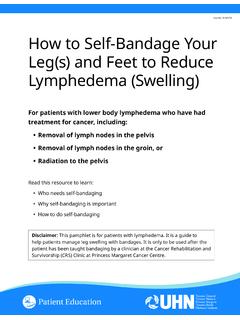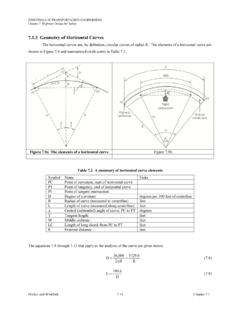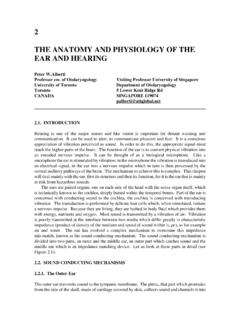Transcription of UV X IND - epa.gov
1 UVA GUIDE TO THEINDEX1-23-56-78-1011+ The Ultraviolet (UV) Index, developed in 1994by the National Weather Service (NWS) and Environmental Protection Agency (EPA),helps Americans plan outdoor activities to avoidoverexposure to UV radiation and thereby lowertheir risk of adversehealth effects. UV radia-tion exposure is a riskfactor for skin cancer,cataracts, and other ill-nesses. The incidence ofskin cancer, includingmelanoma, has increasedsignificantly in the UnitedStates since the early1970s. The UV Index is INCIDENCE IN THE UNITED STATES(per 100,000 people)Source: National Cancer Institute SEER ProgramThe UV Index is a useful tool to help the general public take steps toreduce their exposure to solar UV radiation, but its effectiveness dependson how well the information is communicated to thepublic. This brochure provides important information onnew reporting guidelines for solar ultraviolet is intended to assist communicators in several fields meteorology, public health, education, and the news media in conveying UV information to the public.
2 Professionals in these fieldsare uniquely positioned to raise awareness of how to prevent skin in May 2004, EPA and NWS will report the UV Index consistentwith guidelines recommended jointly in 2002 by the World HealthOrganization (WHO), the World Meteorological Organization, the UnitedNations Environment Programme, and the International Commission onNon-Ionizing Radiation Protection. These organizations recommended aGlobal Solar UV Indexin order to bring worldwide consistency to UV reportingand public health The UV Index was previously reported ona scale of 0 to 10+, with 0 representing Minimal and 10+ representing Very High. As of May 2004, EPA andNWS will report the Global Solar UVIndex using a scale of 1 (or Low ) to 11 and higher (or Extreme ).Additional differences include a newcolor scheme, revised exposure categories, and different breakpointsbetween exposure the categories have been reorganized and labeled, actual UV levels associated with the exposure categories in the Global Solar UV Index have not changed.
3 In other words, a UV index report of 6 represents thesame intensity UV radiation on both the old and new scales, even if 6 iscalled Moderate on the old scale and High on the new scale. The UV Index informs the public of the levelof UV exposure expected on a given day. It isreported as a prediction of the UV level atnoon, although the actual UV level rises andfalls as the day reporting of the index will help the public better understandUV risk. We therefore strongly urge providers of the UV Index to adopt the new scale and color color scheme rangesfrom green (for Low ) to violet (for Extreme ).What s New About theUV Index?3 The UV Index reminds people to protect themselves when engaging in theirnormal outdoor activities. UV radiation exposure poses varying degrees ofrisk for all people because it affects eyes and skin. People with sensitive skinshould always take action to protect themselves. It is especially importantthat parents and caregivers know how to protect babies and young childrenwho are more susceptible to the UV IndexWhen used correctly, shade, clothing, and hats provide the best protection from UV radiation.
4 While sunscreen is effective when applied properly, doctors cautionthat sunscreen should not be used to prolong the duration of sun Protection MessagesWhen reporting or discussing the UV Index, it might be helpful to give your audiencemore information about the significance of the reported UV Index for a given day by suggesting simple actions they can take to avoid overexposure. For this reason,EPA recommends that you use some of the messages identified in the chart belowwhen reporting the UV Index. The Myths and Realities About Fun in the Sunonpage 6 of this brochure may also be useful as health tips. 4 EPA recommends that communicatorsalways encourage individuals to understand and practice the followingsun protection steps: Check the UV Index for the UV forecast. Limit exposure during midday hours. Seek shade. Wear clothing made from tightlywoven fabrics. UV rays can passthrough holes and spaces in looselyknit fabric. Long-sleeved shirts andpants are recommended.
5 Wear a hat with a wide brim that protects the eyes, face, and neck. Wear sunglasses that provide 100%UV protection. Use broad spectrum sunscreens withat least Sun Protection Factor (SPF)15 and reapply regularly. Remember to apply sunscreen on any part of theskin that is exposed to the sun, suchas the nose, the back of the neck, andthe rims of the ears. Use lip balms orcreams containing sunscreen. Different areas of the country have different degrees of variation in the UV Index from day to day and from season to should consider how best to report the UV Indexvalue to their audience so that people actually put recommendationsinto practice and use the UV Index as a guide to healthy UV levels in your area tend to be unchanging particularly ifthey are consistently high during summer months EPA suggeststhat you emphasize general sun protection steps (for example,reminding people to wear sunglasses with 100% UVA & UVB protection); make note of local factors that can affect daily UV levels; and encourage special protection for UV INDEX VALUEW interSummerAtlanta, Georgia2 (Low)8 (Very High)Phoenix, Arizona3 (Moderate)10 (Very High)Anchorage, Alaska<1 (Low)3 to 4 (Moderate)Honolulu, Hawaii6 (High)11 to 12 (Extreme)New York, New York1 to 2 (Low)6 to 7 (High)Portland, Oregon1 (Low)5 to 6 (Moderate-High)St.
6 Louis, Missouri1 to 2 (Low)7 to 8 (High-Very High)Miami, Florida4 (Moderate)10-11 (Very High-Extreme)Typical UVI values for different parts of the at midday. These valuesmay vary significantly depending on cloud cover and ozone THE UV INDEX IS CALCULATEDThe UV Index represents the amount of skin-damaging UV radiation reaching the earth s surface at any instant of basic UV Index forecast is given for solar noon the sun s highest point in the sky and the time of the highest fluctuation in UV radiation (under clear sky conditions). A UV Index forecast begins with a forecast of the total ozoneamount. All the forecast parameters used in the UV Indexcomputation are derived from NWS forecast models. The sunangle at solar noon (or for any other time) for that day is determined. A radiative transfer model determines the flux ofUV radiation for a range of wavelengths. An action spectrumweights the response of the human skin to UV radiation ateach wavelength.
7 Once weighted, the flux values are integratedover the entire range, resulting in an erythemal dose rate the instantaneous amount of skin-damaging radiation reachingthe surface under clear sky, at sea level, with low aerosol conditions, as measured by units of milliWatts per squaremeter. Adjustments then account for a location s elevation,aerosol, and cloud conditions. Next, the optical properties of cloud conditions expected at that time refine the dose rate further. Finally, the resultant dose rate is applied to theUV Index. One UV Index unit is equivalent to 25 milliWattsper square COVER, such as structures and trees, significantly reduces exposure to UV in the UV IndexThe intensity of the sun s UV rays reaching the earth s surface, and the UV Index ratings, vary according to many factors. All influence the UV Index in locations across the affect UV radiation, which peaks in spring and summer (April to August), declines in fall, and is lowest in OF DAY affects UV radiation, which peaks at midday (with the sun highest in the sky), and lessens in the early morning and late affects UV radiation, which is strongest at the equator and declines toward the affects UV radiation; UV increases about 2% for every 1,000- foot increase in elevation due to thinner mountain COVER, if heavy, can block most UV radiation.
8 Thin or broken clouds allow most UV rays through. Puffy, fair-weather clouds deflect rays and can increase UV radiation reaching the absorbs UV radiation. The higher the amount of ozone, the fewer rays reach the surface. Ozone levels vary from day to day and throughout the SURFACE CHARACTERISTICS can reflect or scatter UV radiation. Snow may reflect as much as 80% of UV, sand 15%, and water 10%. Overexposure to the sun s ultraviolet rays is the mostimportant preventable factor in the development ofskin cancer. Skin cancer is largely preventable whensun protection measures againstUV rays are used , many young peopleand adults do not consistentlyuse sun protection measuresand are unaware of the linkbetween overexposure andhealth risks. Reporting Burn Times Not RecommendedCommunicators sometimes report time to burn in lieu of the UVIndex level, as a simple concept thatcan easily be translated into , people can interpret burntimesas a safe periodduring whichthey do not have to take protectiveaction.
9 Relating UV Index values to time to burn or safe tanning time sends an incorrect and potentiallyharmful message to the generalpublic. The UV Index should not beused to suggest that unprotectedexposure is Radiation and Public HealthMyths and Realities About Fun in the Sun 6 SKIN CANCERUV radiation causes genetic mutations in skin cells. Over time, such mutationsdue to exposure to the sun and severesunburns can lead to skin cancer. Everyyear, more than one million Americansare diagnosed with skin cancer, makingit the most common form of cancer in the country. In the United States, one person dies of skin cancer every most common places for skin cancer to develop are on those bodyparts exposed to the sun, such as theface, neck, ears, forearms, and three main types of skin cancer are basal cell carcinoma, squamous cell carcinoma, and melanoma. Basal carcinomas are tumors that usually appear as small, fleshy bumpsor nodules. Squamous cell carcinomas appear asnodules or as red, scaly patches.
10 Melanomas may appear without warning as a dark mole or other darkspot in the skin. Melanoma causesmore than 75% of skin cancer are more than 50,000 newcases of melanoma per year. One infour persons who develop melanoma is under 40. All three types of skin cancer may besuccessfully treated if detected in theirearly stages. For more information about howto detect skin cancer, visit the Center forDisease Control s skin cancer website most obvious result of too much UV exposure is sunburn, which involves skin redness and sometimestenderness, swelling, blistering, fever,and nausea. However, tanned skin also poses a skin cancer SENSITIVITYSome people may develop bumps, hives, blisters, or red blotchy areas as an allergic reaction to sun drugs, perfumes, and cosmeticsalso may make some people sensitive to the DAMAGEE xcess exposure to UV radiation cancause a painful burn of the eye exposure to UV radiationmay also increase the incidence ofcataract, which is a clouding of the eye lens; pterygium, in which a fleshmembrane covers the eye; and possibly macular degeneration, or thedevelopment of spots that could result in blindness.
















